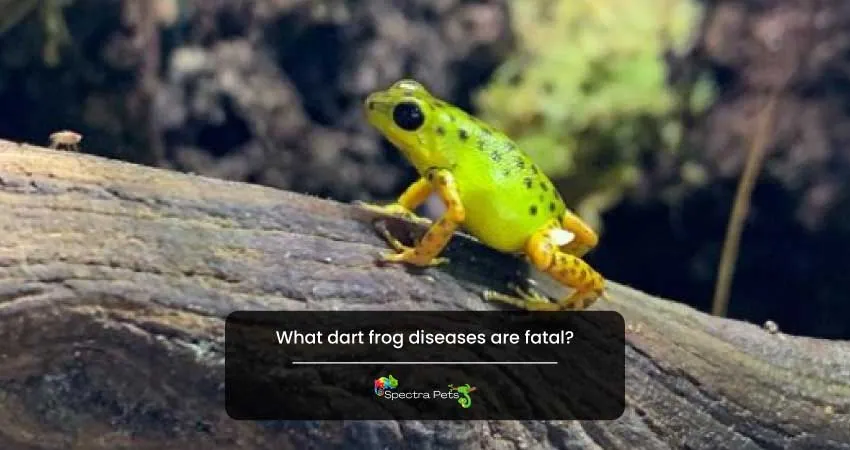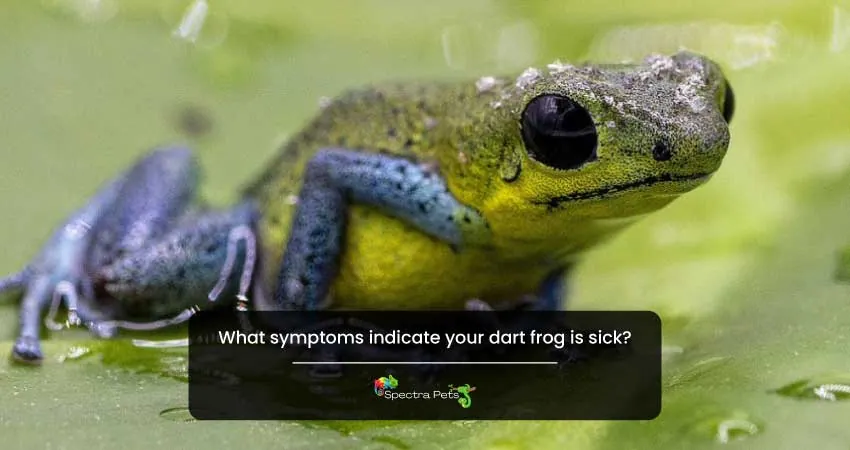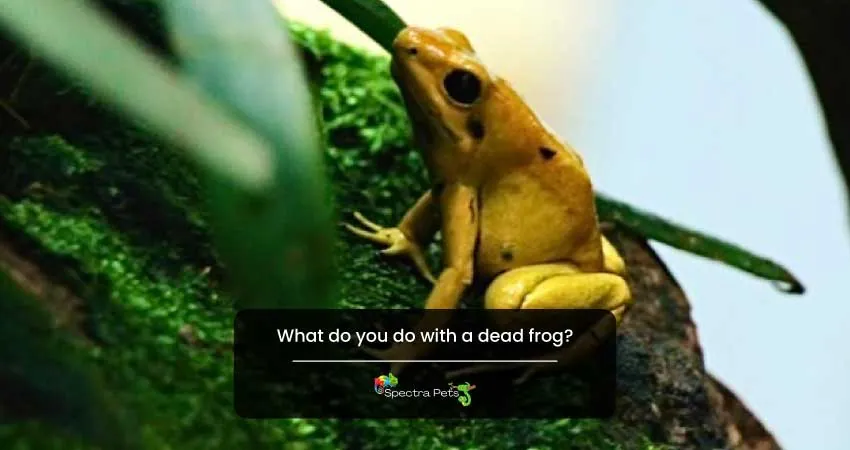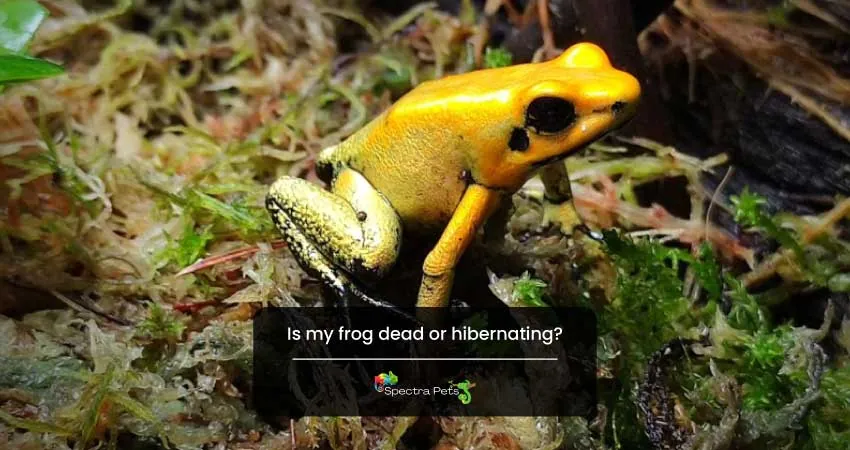If you’ve been a frog owner for any length of time, you’ve probably had to deal with the death of a frog. It’s never easy to lose a pet, no matter how small, but it can be especially tough when you’re not sure why your frog died.
After all, frogs can make great pets! They’re relatively low-maintenance, and they’re interesting to watch. While it’s not always possible to pinpoint the cause of death, there are some common reasons why dart frogs die.
In this blog post, we’ll explore 10 of the most common reasons why dart frogs die.
11 Reasons Why Your Dart Frog May Have Died
It’s natural to feel devastated when your pet dies. And you don’t recover from the grief until you get some kind of closure. Knowing how your beloved pet died is a form of that.

If you’re not sure why your dart frog died, here are 10 possible explanations:
1. Improper Diet
One of the most common reasons for dart frog death is an improper diet. While dart frogs generally have a relatively simple diet in captivity, it is important to ensure that they have a consistent source of food that meets their nutritional needs.
Many hobbyists make the mistake of feeding their dart frogs live insects, which can often be carriers of disease. It is important to only feed your frogs insects that have been properly quarantined and gut-loaded with a nutritious diet themselves.
In addition, it is important to offer a variety of different types of food to ensure that your frogs are getting all the nutrients they need. A lack of vitamins and minerals can lead to a host of health problems, so it is important to consult with a reptile veterinarian if you are unsure about your frog’s diet.
However, abstain from overfeeding your frogs as well. Overweight frogs are more susceptible to a number of health problems. Check out what does a dart frog eat for some guidance about their food habits.
2. Inappropriate Temperature
Dart frogs are native to tropical climates and therefore require warm temperatures to survive. In the wild, they can be found near bodies of water where the air is thick with moisture. Captive dart frogs, on the other hand, are typically kept in terrariums where the temperature is carefully controlled.
If the temperature in your frog’s enclosure drops too low(below 65 degrees F), it can cause a number of health problems that could lead to death. Also, a high temperature (above 85 degrees F) can be just as deadly to dart frogs. So, it’s important to use a thermometer to closely monitor the temperature in your frog’s enclosure to avoid any drastic changes.
3. Improper Water Quality
Another common cause of dart frog death is poor water quality. In the wild, dart frogs live near water sources that are teeming with microorganisms. This exposure helps to build their immune systems and keep them healthy.
In captivity, however, dart frogs are typically kept in sterile environments where they are not exposed to these beneficial microorganisms. As a result, their immune systems are not as strong, and they are more susceptible to disease.
Sometimes new frog owners start providing their frogs water from their tap, not knowing that chlorine and other chemicals present in the water can be harmful.
To help keep your frogs healthy, it is important to use a high-quality water filter and to perform regular water changes. This will help to remove any harmful elements like ammonia and nitrites from the water, and it will also help to maintain a healthy pH level.
4. Inappropriate Humidity level
Humidity refers to the amount of water vapor present in the air. Dart frogs are native to the rainforests of Central and South America, so they require a humid environment to thrive. Therefore, too little humidity can be detrimental to your dart frog’s health.
Ideally, the humidity level in your frog’s enclosure should be between 80-100%. When they are placed in an enclosure that does not have enough humidity(below 50%), they quickly start to dehydrate and can become extremely sick. If the humidity level is not corrected, the frog will eventually die. Their humidity requirements are similar to pacman frogs.
Maintaining the proper humidity level is therefore essential for keeping dart frogs healthy. There are a few different ways to do this, such as misting the enclosure regularly or using a humidifier.
Be careful, over-misting can also lead to health problems, so it is important to find the right balance. You can use a hygrometer to measure and maintain the humidity level in your frog’s enclosure.
5. Disease or Infection
If you’re wondering why your dart frog died, one possibility is that it succumbed to disease or infection. Common symptoms of illness in dart frogs include weight loss, lethargy, and changed behaviors such as reduced activity levels or hiding. If your frog was displaying any of these signs, it’s possible that it was already sick when you got it.
Alternatively, your frog may have contracted an infection from its tankmates or from contact with humans. Infections can spread quickly in captive populations of frogs, so it’s important to take steps to prevent them.
Quarantining new frogs, maintaining clean tanks, and washing your hands before handling your frogs can help to reduce the risk of infection. If you think that disease or infection may have been a factor in your frog’s death, it’s important to consult with a veterinarian to get a definitive answer.
6. Pesticides and other Chemicals
Pesticides and other chemicals can be extremely harmful to dart frogs. In the wild, these chemicals are often present in the environment and can enter the frogs through their skin. In captivity, these chemicals can enter the frogs’ environment through contaminated food, water, or soil.
Exposure to these chemicals can lead to a variety of health problems in frogs, including organ damage, respiratory problems, and neurological problems. In severe cases, chemical exposure can be fatal.
To help protect your frogs from these harmful chemicals, it is important to use only products that are safe for frogs and to avoid exposure to any potential sources of contamination.
7. Overcrowding
Overcrowding can also lead to health problems in dart frogs. In the wild, these frogs live solitary lives and only come together to mate.
In captivity, however, it is common for frogs to be kept in groups. While this can be fun for the frogs owner, it can also lead to stress and health problems.
When frogs are kept in an enclosure that is too small or that has too many frogs, they can become stressed. This can lead to a weakened immune system, which makes the frogs more susceptible to illness.
In addition, overcrowding can also cause behavioral problems, such as aggression. As a result, one frog may bully another and cause injury or death.
It is therefore important to provide your frogs with plenty of space and to monitor them closely if they are kept in groups.
8. Incorrect Housing structure
If your dart frog’s tank isn’t set up correctly, it will quickly perish. One of the biggest mistakes people make is not providing enough ventilation.
Dart frogs produce a lot of waste, and the terrarium/vivarium needs to have good airflow in order to keep the air clean. Using the wrong substrate can also be fatal for a frog.
The substrate should be safe to eat in case the frog accidentally ingests it, and it should also retain moisture to help keep the humidity level high.
Another common mistake is providing fewer hiding places. Dart frogs are shy, timid creatures, and they need a lot of places to hide in order to feel secure. If their tank doesn’t have enough hiding spots, they will become stressed and can’t live freely.
The last thing to keep in mind is the size of the enclosure. A tank less than 10-gallon is too small for even one dart frog, let alone multiple frogs. The larger the enclosure, the better. This will give your frog enough space to move around and feel comfortable.
Read more from our dart frog habitat setup guide.
9. Handling the frog too much
Handling any animal too much can stress it out and cause health problems, but this is especially true for Dart frogs. These fragile amphibians are very sensitive to changes in their environment, and too much handling can disturb their natural routine.
It also puts stress on the frog, which can weaken its immune system and make it more susceptible to illness.
In addition, the oils on our skin can be harmful to their delicate skin. If you must handle your frog, be sure to wash your hands thoroughly first and avoid handling them more than necessary.
Try not to handle them at all during the first few weeks after you bring them home, as this will give them time to adjust to their new environment.
10. Lack of Cleanliness
Any animal owner knows that cleanliness is important for keeping your pet healthy. This is especially true for dart frogs, which are highly sensitive to changes in their environment. If their enclosure is not cleaned regularly, they can develop health problems that can lead to death.
In the wild, dart frogs live in tropical rainforests where they have access to plenty of fresh water. They use this water to keep their skin moist, which helps to keep them healthy and free of bacteria. In captivity, however, dart frogs often have to make do with stagnant water that is not changed often enough. As a result, their skin can become dry and cracked, making them susceptible to infection.
To avoid this, it is important to clean your dart frog’s enclosure on a regular basis(at least once a week), and provide them with fresh water daily. Also, any uneaten food or waste should be removed promptly to prevent the spread of disease.
11. Natural causes
Out of all the reasons your dart frog could have died, natural causes are potentially the most difficult to swallow. After all, you didn’t do anything wrong- so how could nature be to blame? Natural causes can include everything from old age to poor captive breeding practices by the supplier.
If your dart frog was wild caught, there is also the potential that it was already sick or injured when you brought it home. When it comes to captive-bred frogs, inbreeding can also lead to health problems that shorten their lifespan. Although it’s hard to accept, sometimes nature just isn’t on our side.
What dart frog diseases are fatal?

The three most dangerous diseases for dart frogs are chytridiomycosis, red leg disease, and Ranavirus.
However, the most frequent cause of death in dart frogs is chytridiomycosis, a fungal infection that affects the skin. This disease is often spread through contaminated water, and it can be fatal if left untreated.
Moreover, Ranavirus is a highly contagious virus that can affect both tadpoles and adult frogs, causing severe inflammation, organ damage, and death.
Red-leg disease is caused by a bacterium that attacks the underside of your dart frog’s leg.
What symptoms indicate your dart frog is sick?

As any pet owner knows, it can be difficult to tell when your animal is sick. This is especially true for amphibians, who often disguise their illness until it is too late. However, there are some signs that your dart frog may be ill.
For instance, frogs that are normally active during the day may become lethargic and spend more time hiding. In addition, sick frogs may have a loss of appetite and difficulty moving around. Also, you may notice changes in their skin, such as redness, shedding, or ulcers.
If you notice any of these symptoms in your dart frog, it is important to take them to a veterinarian as soon as possible. With prompt treatment, many dart frogs can make a full recovery.
What do you do with a dead frog?

If you unfortunately have to deal with a dead frog, please follow the below-given steps and handle the situation accordingly with compassion and care.
The first thing you need to do is to remove the frog from its home. This may seem like an obvious step, but it’s an important one. Having a dead animal in the frog enclosure can cause health problems for the other frogs.
In addition to attracting pests, it can also be emotionally difficult for you and your family. If possible, place the frog in a zip-top bag and put it in the freezer until you can dispose of it properly.
Next, you’ll need to decide whether you want to bury or cremate your frog. Burying your frog will allow you to memorialize them in a way that feels natural. Cremating your frog will allow you to keep their ashes, but it does require access to a crematorium. Therefore, I suggest you bury your frog.
Finally, you’ll need to decide what to do with your frog’s belongings. If your frog had a tank or other type of enclosure, you’ll need to clean it thoroughly before using it for another pet. If you don’t want to pet any more frog’s, you may want to donate the enclosure to a local reptile rescue.
Is my frog dead or hibernating?

There are several key differences between frogs that are dead and those that are merely hibernating. Here are a few things to look for:
Movement: Frogs in hibernation will typically be very still. If you try to move them, they may resist slightly, but for the most part, they will not react to outside stimuli. Dead frogs, on the other hand, will be completely unresponsive to anything.
Skin color: A dead frog’s skin will often appear pale or blotchy. A hibernating frog’s skin may look dry and dull, but it should not have any obvious color changes.
Breathing: Frogs in hibernation will usually exhibit shallower and slower breathing than normal. Dead frogs will not be breathing at all.
Body Temperature: Hibernating frogs will typically have a lower body temperature than usual. Dead frogs will be completely cold to the touch.
Finally, if you pick up a hibernating frog and gently shake it, it will usually wake up and resume its normal activity levels within a few minutes. Dead frogs will not react no matter how much you shake them.
Final Words
Losing loved ones is an extremely pathetic experience and it feels even worse when you realize that it’s your fault that your cute frogs are paying. But, I know, you didn’t do this intentionally.
Now, you have learned almost all the possible reasons behind the certain and uncertain demise of a dart frog. Hopefully, the above-given information will help you take far better care of your remaining dart frogs and prevent any silly heartbreaking deaths.
Similar Article:

